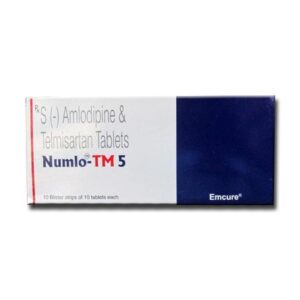S-AMLODIPINE + TELMISARTAN
S-Amlodipine: S-Amlodipine is a medication used to treat high blood pressure (hypertension) and certain types of chest pain (angina). It belongs to the class of drugs known as calcium channel blockers.
The mechanism of action of S-Amlodipine involves blocking the influx of calcium into the smooth muscle cells of the blood vessels and heart. This results in the relaxation and widening of the blood vessels, thereby reducing blood pressure and improving blood flow. By dilating the coronary arteries, it also increases oxygen supply to the heart.
The typical starting dose of S-Amlodipine for adults is 2.5-5 mg once daily, which can be increased to a maximum of 10 mg as needed to achieve the desired blood pressure control. The dosage may vary depending on individual patient factors such as age, medical condition, and response to treatment.
Like any medication, S-Amlodipine can cause side effects. Common side effects may include headache, dizziness, fatigue, flushing, nausea, and ankle swelling. These side effects are usually mild and transient. However, if they persist or worsen, it is important to consult a healthcare professional.
Rare but potentially serious side effects may include low blood pressure (hypotension), irregular heart rhythms, and allergic reactions. If any of these occur, immediate medical attention should be sought.
It is important to note that S-Amlodipine may interact with certain medications, such as other blood pressure-lowering drugs, which may increase the risk of low blood pressure. It is recommended to inform healthcare providers about all the medications, vitamins, and herbal supplements being taken to prevent potential drug interactions.
Overall, S-Amlodipine is a widely used drug for the treatment of hypertension and angina. Its effective mechanism of action, convenience of once-daily dosing, and relatively low incidence of side effects make it a commonly prescribed medication for these conditions. However, it is essential to follow dosage instructions and consult a healthcare professional for personalized guidance and monitoring.
Telmisartan: Telmisartan is a medication that belongs to a class of drugs known as angiotensin II receptor blockers (ARBs). It is primarily used to treat high blood pressure (hypertension) in adults. Telmisartan works by blocking the action of angiotensin II, a hormone that causes blood vessels to constrict and promotes the release of another hormone called aldosterone, which leads to salt and fluid retention. By inhibiting the effects of angiotensin II, Telmisartan helps to relax blood vessels, lower blood pressure, and improve blood flow.
The usual starting dose of Telmisartan for the treatment of hypertension is 20 mg once daily. However, the dosage can be increased to a maximum of 80 mg if necessary. It can be taken with or without food, and the medication should be taken at the same time each day for maximum effectiveness.
Like all medications, Telmisartan can cause side effects. The most common side effects include dizziness, headache, nausea, diarrhea, sinusitis, and upper respiratory tract infections. It may also cause low blood pressure, which can result in symptoms like weakness, fatigue, and lightheadedness. Rarely, Telmisartan may also lead to an allergic reaction, indicated by symptoms such as rash, itching, swelling, severe dizziness, and trouble breathing. It is important to consult a healthcare professional if any unusual or severe side effects occur.
Telmisartan is a prescription medication, and its use should be determined and monitored by a healthcare professional based on an individual’s specific medical condition, other medications, and overall health. It is not recommended for use during pregnancy as it may harm the unborn baby, and it is also advisable to avoid it if breastfeeding. Discussing any concerns or questions with a healthcare provider is essential for safe and effective use of Telmisartan.

